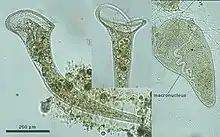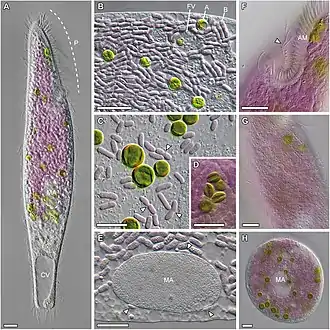Heterotrich
The heterotrichs are a class of ciliates. They typically have a prominent adoral zone of membranelles circling the mouth, used in locomotion and feeding, and shorter cilia on the rest of the body. Many species are highly contractile, and are typically compressed or conical in form.[1] These include some of the largest protozoa, such as Stentor and Spirostomum, as well as many brightly pigmented forms, such as certain Blepharisma.
| Heterotrich | |
|---|---|
 | |
| Stentor roeselii | |
| Scientific classification | |
| Domain: | Eukaryota |
| Clade: | Diaphoretickes |
| Clade: | SAR |
| Clade: | Alveolata |
| Phylum: | Ciliophora |
| Subphylum: | Postciliodesmatophora |
| Class: | Heterotrichea Stein 1859 |
| Order: | Heterotrichida Stein 1859 |
| Families | |
| |
Etymology
The term heterotrich derives from the ancient Greek ἕτερος (héteros), meaning "another, different", and θρίξ, τριχός (thríx, trikhós), meaning 'hair',[2][3] because of the contrast between the regular somatic ciliation and the one of the oral zone.[4]
Ultrastructure
A number of ultrastructural details characterize the group. The cilia on the body are in dikinetids, in which either the anterior one or both kinetosomes may be ciliated, and which are associated with fibers composed of overlapping postciliary microtubules, called postciliodesmata and found only in this group and the closely related Karyorelictea. A series of oral polykinetids, each containing two or three rows of kinetosomes, support the membranelles. These run from the left to the anterior of the mouth, and often spiral out of the oral cavity. The macronucleus is divided by external microtubules, whereas in the Karyorelictea it forms by differentiation of micronuclei, and in all other ciliates it is divided by internal microtubules.[5][4]
Pigmentation
Many species are highly pigmented, e.g. the blue Stentor coeruleus. In Blepharisma, the red pigment is associated with light sensitivity. Species of blue-pigmented Eufolliculina form extensive mats in the deep sea that have been called "blue mats".[6]
Systematics

Early classification schemes by Otto Bütschli, Alfred Kahl, Emmanuel Fauré-Fremiet, and John O. Corliss classified the heterotrichs as a subgroup of spirotrichs. They included groups such as Armophorida, Odontostomatida, Licnophorida, Clevelandellida, and Plagiotomida within the Heterotrichea. However, more recent classification systems, which have incorporated information from molecular phylogenetics, place the above groups within the Intramacronucleata, because they are not closely related to the "core" heterotrichs at all.[4] Almost all of the "true" heterotrichs belong to a single order, Heterotrichida.
In the classification scheme of Lynn (2008), the order Heterotrichida contains the following nine families:[4]
- Blepharismidae Jankowski in Small & Lynn, 1985
- Chattonidiidae Villeneuve-Brachon 1940
- Climacostomidae Repak, 1972
- Condylostomatidae Kahl in Doflein & Reichenow, 1929
- Folliculinidae Dons, 1914
- Maristentoridae Miao, Simpson, Fu & Lobban 2005
- Peritromidae Stein, 1867
- Spirostomidae Stein, 1867
- Stentoridae Carus, 1863
Two new families were established in 2014 on the basis of molecular phylogenies:[5]
- Gruberiidae
- Fabreidae
References
- Lobban, Christopher S.; Schefter, María (2016-01-01). "An Integrated Model of the Biology of the Marine Symbiosis Maristentor dinoferus". In Witzany, Guenther; Nowacki, Mariusz (eds.). Biocommunication of Ciliates. Springer International Publishing. pp. 305–326. doi:10.1007/978-3-319-32211-7_17. ISBN 9783319322094.
- Bailly, Anatole (1981-01-01). Abrégé du dictionnaire grec français. Paris: Hachette. ISBN 978-2010035289. OCLC 461974285.
- Bailly, Anatole. "Greek-french dictionary online". www.tabularium.be. Retrieved 2017-01-24.
- Lynn, Denis H. (2008). The Ciliated Protozoa: Characterization, Classification, and Guide to the Literature. 3rd Edition. Springer. pp. 129. ISBN 978-1-4020-8238-2.
- Shazib, Shahed Uddin Ahmed; Vd’ačný, Peter; Kim, Ji Hye; Jang, Seok Won; Shin, Mann Kyoon (2014). "Phylogenetic relationships of the ciliate class Heterotrichea (Protista, Ciliophora, Postciliodesmatophora) inferred from multiple molecular markers and multifaceted analysis strategy". Molecular Phylogenetics and Evolution. 78: 118–135. doi:10.1016/j.ympev.2014.05.012. PMID 24859684.
- "Sunday Protist -- Blue Mats of the deep sea: Folliculinopsis". skepticwonder.fieldofscience.com. Retrieved 2017-07-25.
- NCBI: Pseudoblepharisma tenue (species)
- NCBI: Thiodictyon endosymbiont of Pseudoblepharisma tenue (species)
- Muñoz-Gómez, SA; Kreutz, M; Hess, S (June 2021). "A microbial eukaryote with a unique combination of purple bacteria and green algae as endosymbionts". Science Advances. 7 (24). Bibcode:2021SciA....7.4102M. doi:10.1126/sciadv.abg4102. PMC 8195481. PMID 34117067.